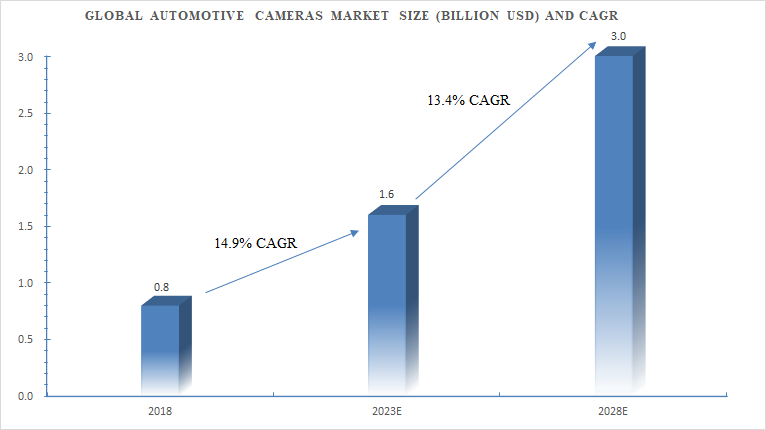Automotive Cameras Producers and Automotive Cameras Market Trend
In recent years, automotive cameras have emerged as the cornerstone of Advanced Driver Assistance Systems (ADAS), leveraging image recognition algorithms to collect and analyze data for intelligent driving. These in-car cameras, primarily serving as visual sensors, boast higher resolutions than other sensors, enabling the capture of intricate environmental details. However, they are susceptible to external factors such as weather conditions. Automotive cameras are categorized into various types, including front-view, surround-view, side-view, rear-view, and interior cameras.
From 2018 to 2023, the global automotive camera market has witnessed significant expansion, with revenues surging from $0.8 billion to $1.6 billion at a Compound Annual Growth Rate (CAGR) of 14.9%. Projections indicate that the market is set to reach $3.0 billion by 2028, sustaining a CAGR of 13.4% from 2023 to 2028.
 The hardware components of automotive cameras encompass optical lenses (lens, filters, protective coatings), CMOS image sensors, Image Signal Processors (ISP), and serializers. Among these, CMOS sensors hold the highest value, constituting 50% of the total cost, while module packaging accounts for 25%, and optical lenses make up 14% of the costs.
The hardware components of automotive cameras encompass optical lenses (lens, filters, protective coatings), CMOS image sensors, Image Signal Processors (ISP), and serializers. Among these, CMOS sensors hold the highest value, constituting 50% of the total cost, while module packaging accounts for 25%, and optical lenses make up 14% of the costs.
Key players in the global automotive camera market include:
Onsemi (Market Share: 22.6%)
OmniVision (Market Share: 15.1%)
Sunny Optical (Market Share: 5.2%)
Sony (Market Share: 5.0%)
Magna (Market Share: 4.4%)
Panasonic (Market Share: 3.5%)
 These companies continue to drive innovation in the industry, developing cutting-edge technologies to enhance the performance and reliability of automotive cameras.
These companies continue to drive innovation in the industry, developing cutting-edge technologies to enhance the performance and reliability of automotive cameras.
In addition to their primary role in ADAS, automotive cameras find applications in various areas, including:
Lane Departure Warning Systems: Automotive cameras assist in detecting lane markings and provide real-time feedback to the driver to prevent unintentional lane departures.
Adaptive Cruise Control: These cameras are integral to maintaining safe following distances by tracking the speed and position of vehicles ahead.
Parking Assistance: Automotive cameras facilitate parking by offering a clear view of the surroundings, enabling drivers to navigate tight spaces effortlessly.
Pedestrian Detection: By recognizing pedestrians and cyclists, automotive cameras contribute to pedestrian safety and accident prevention.
Traffic Sign Recognition: These cameras can identify and display important traffic signs and warnings to the driver.
The global automotive camera market's growth is propelled by the continuous development of autonomous driving technologies, safety regulations mandating the incorporation of ADAS features, and consumers' increasing demand for enhanced driving experiences. As automotive cameras become more integral to vehicle safety and automation, we can expect further advancements and innovations in this thriving industry.